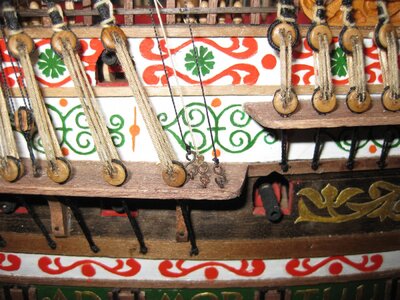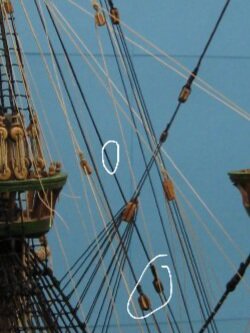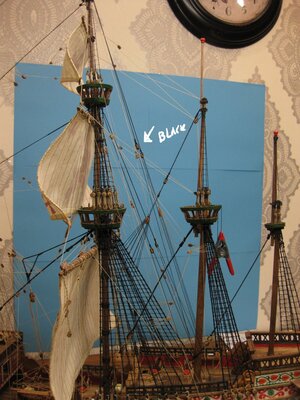I really like this idea of attaching hard to reach belay points, early, so that you can run the lines later - excellent suggestion!Hey Paul,
First, I wanted to say it looks like you had a great vacation, and were fortunate enough to meet up with Maarten. That was really nice of him.
Second, when it comes to the order of rigging, I am no expert, and this may be rhetorical to say, but I believe it is somewhat intuitive in the sense that you complete standing rigging first... and then the rigging to raise the yards on the masts next, before finally completely the running rigging for the sails. You can work bow to stern, but I am not sure if that really matters. And finally, you can always tie off rigging to the belaying pins of hard to reach areas, prior to running the line to the sail. I realize that is very general, but is how I have approached rigging with my limited experience! I wish I had more to offer!
-

Win a Free Custom Engraved Brass Coin!!!
As a way to introduce our brass coins to the community, we will raffle off a free coin during the month of August. Follow link ABOVE for instructions for entering.
You are using an out of date browser. It may not display this or other websites correctly.
You should upgrade or use an alternative browser.
You should upgrade or use an alternative browser.
Vasa - 1:65 DeAgostini [COMPLETED BUILD]
- Thread starter dockattner
- Start date
- Watchers 147
We are lucky - there are a few perfect builds of Vasa riggings in progress, in various stages right now... so we could see everything in details!!!
And there are not too big differences in Vasa and SR rigging, at least in that versions which are represented on the models.
And there are not too big differences in Vasa and SR rigging, at least in that versions which are represented on the models.
There are not too much such belaying points of running rigging which could be impossible to reach... a few may be...doubt need to make them in reverse order ....I really like this idea of attaching hard to reach belay points, early, so that you can run the lines later - excellent suggestion!
suggest first assemble sail with yard and all relevant blocks...
make all necessary slacks of rigging , secure lines passes trough blocks with drop of ca gell to fix those slacks,...
and than fitt this assembled unit to the mast,
After that you will have to pass free remaining end of rigging line to belaying pin ,to clue it here and to cut.
Than need to form coiled rope separately and place it above cutted end of the rigging line.
For me it was most important to make in reverse order fitting of lower sails Ties and Halliards...I found it most handy, first to adjust necessary length of ties halliards , assemble tie halliard knight,halliard and lower tie block,
than secure preassembled yard to the mast - fitted it on the metal pin, and after that to pass running end of ties upward, trough sheaves in mast head( or trough blocks - depends on construction) and secure running end on the yard with special kind of knots.
Could you please clarify this part. Are you saying you rigged at the knightshead first, installed the yards, and then ran the halyard to the yard?For me it was most important to make in reverse order fitting of lower sails Ties and Halliards...I found it most handy, first to adjust necessary length of ties halliards , assemble tie halliard knight,halliard and lower tie block,
than secure preassembled yard to the mast - fitted it on the metal pin, and after that to pass running end of ties upward, trough sheaves in mast head( or trough blocks - depends on construction) and secure running end on the yard with special kind of knots.
Yes , correct ...  ))
))
than it easy to adjust necessary length of halliards ...
depends on main yard position( which meanwhile fixed to the mast on the metall pin...but this pin invisiable between mast and yard and it will imitate weight of the yard ... wnich is weight nothing on the model, but we need to show ties tensions and when install parrels, it also need to be fixed against mast), calculate and adjust correct height/ lenght of halliards...depends on position of the yard...
meanwhile ,when you are busy with halliards adjustment ,ties running ends passed through upper tie block (that one above the knight), and run up to the mast head , trough sheeves in the top, pass above yard and temporary are kept in tension with weight of couple of metall paper clips...
After that( halliards adjusted and fixed) , you just run ties ends around yards where they should be, made that special knots and imitate tension of the ties and apply couple of lashings...
should looks same as it shown in the books...
In reverse order I also made main stay and mizzen stays... but I did it because of special kind of knots I used to form stay loop...
I think it will not work with Vasa stays, to make them in complete reverse order...
as example of reverse :
- mizzen tie halliard and bonaventura stay made in reverse order - as You can see,
* lower tie halliard length adjusted,
*tie passed trough sheeve in mizzen top ,tensioned and clued ..
*later on mizzen sail itself with all rigging will be attached at place on the wire pin , and after that tie rigging will be finished - parrals installed ,some lead blocks etc.
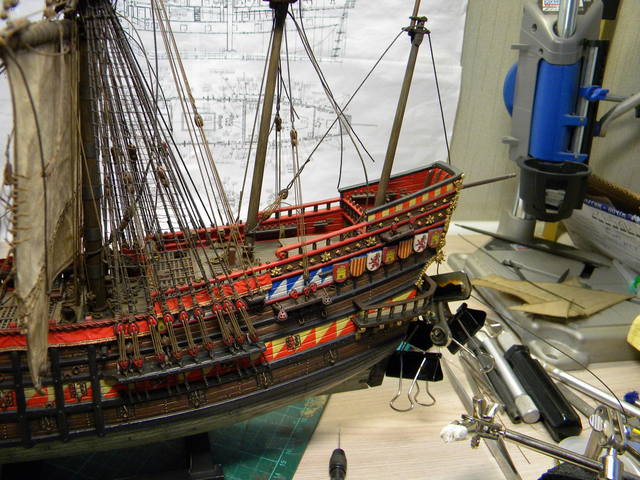
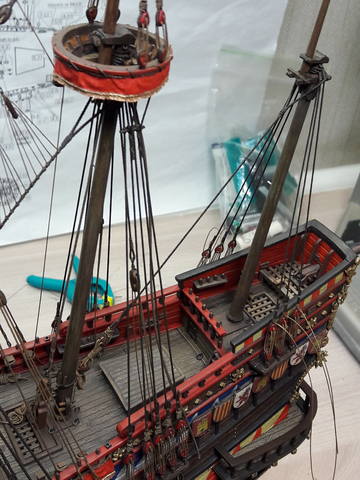
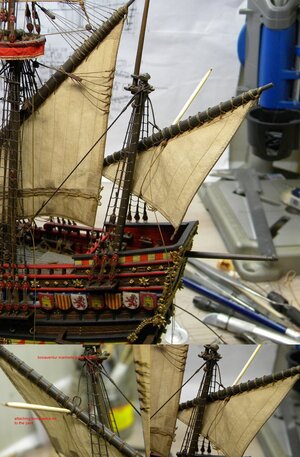
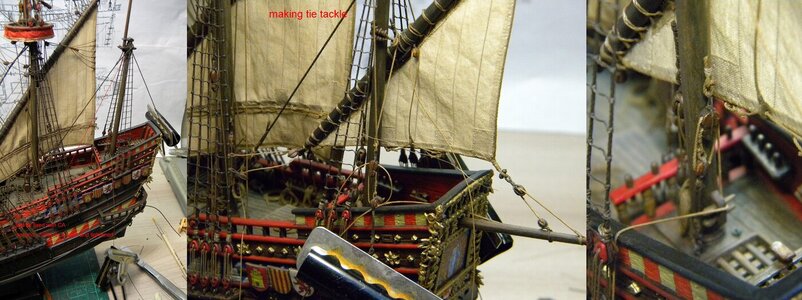
than it easy to adjust necessary length of halliards ...
depends on main yard position( which meanwhile fixed to the mast on the metall pin...but this pin invisiable between mast and yard and it will imitate weight of the yard ... wnich is weight nothing on the model, but we need to show ties tensions and when install parrels, it also need to be fixed against mast), calculate and adjust correct height/ lenght of halliards...depends on position of the yard...
meanwhile ,when you are busy with halliards adjustment ,ties running ends passed through upper tie block (that one above the knight), and run up to the mast head , trough sheeves in the top, pass above yard and temporary are kept in tension with weight of couple of metall paper clips...
After that( halliards adjusted and fixed) , you just run ties ends around yards where they should be, made that special knots and imitate tension of the ties and apply couple of lashings...
should looks same as it shown in the books...
In reverse order I also made main stay and mizzen stays... but I did it because of special kind of knots I used to form stay loop...
I think it will not work with Vasa stays, to make them in complete reverse order...
as example of reverse :
- mizzen tie halliard and bonaventura stay made in reverse order - as You can see,
* lower tie halliard length adjusted,
*tie passed trough sheeve in mizzen top ,tensioned and clued ..
*later on mizzen sail itself with all rigging will be attached at place on the wire pin , and after that tie rigging will be finished - parrals installed ,some lead blocks etc.




Last edited:
Kirill, it is so nice to see your superb galleon again!
Marc, Thanks
Good day! ,
Sorry I posted here too much my pictures, general intention was to show oposite order of rigging stays and tie halliards on the model... sometimes found it much handy than do it in conventional order
Good day! ,
Sorry I posted here too much my pictures, general intention was to show oposite order of rigging stays and tie halliards on the model... sometimes found it much handy than do it in conventional order
- Joined
- Aug 8, 2019
- Messages
- 5,472
- Points
- 738

Your model was one of the reasons I put so much effort in my rigging of my Spanish Galleon. The stern of your model was inspiring me how to handle the stern of my galleon. The time I saw your model for the first time I didn't know nothing of all those ropes and everything was a strange new world to me. Your log, RC Anderson and Peter Kirsch taught me everything.
Maybe you start here a log and show us your build and explanation in English (if you have time)
I did this to my Spanish Galleon, I write an article for "De modelbouwer" It is fun to do
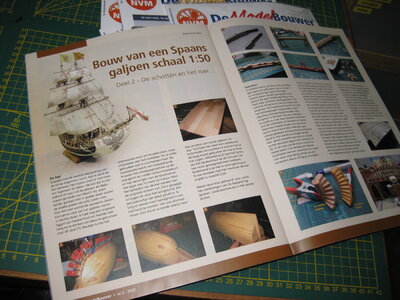
Lol seeing this picture of the magazine I see a big mistake. Scale is 1:66 not 1:50
Good day Stephan,
Thanks!
There is my build log, in plastic https://shipsofscale.com/sosforums/...lee-imai-1-100-may-2021-completed-build.7848/
Thanks!
There is my build log, in plastic https://shipsofscale.com/sosforums/...lee-imai-1-100-may-2021-completed-build.7848/
Gorgeous galleon! A true work of art!
Hello Friends,
It has been quite a while since I have worked on my Vasa. Being on vacation didn't help - but I also feel like I lost my muse and wasn't really motivated once I returned from holiday. Well, today I tried to reboot my build with the challenging mizzen topmast stays. On the Vasa this has a somewhat unusual configuration in that the stay does not run to the main mast on the centerline. Instead, there are two stays with each running to the most aft shroud (port and starboard) of the main mast.
Here is the overall view:
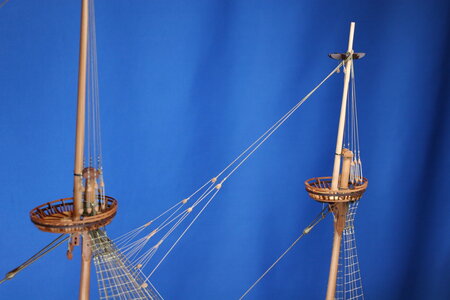
Tensioning these lines was as tricky as you think it would have been. Here is a closer view from the other side of the ship:
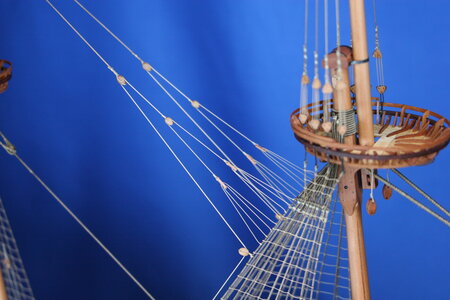
My hero (PeterG) ran the tensioning line to a block/eyebolt on the deck and then to a cleat on the bulwark. I chose to forego the block and ran my line directly to a cleat...
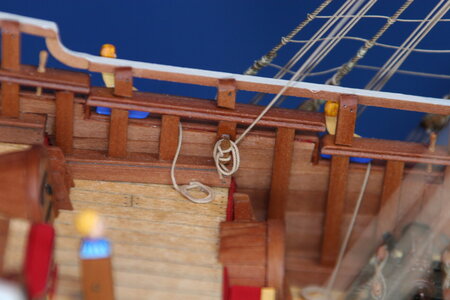
And now I must drag you into an area of Vasa controversy: backstays. Some of my predecessors have included backstays at the centerline. I'll use the foremast as an example of how this is sometimes done by showing you the museum plans where I have marked in the backstays for the topgallant and topmast (I simply 'outlined' the crowsfoot arrangement terminating at the stays):
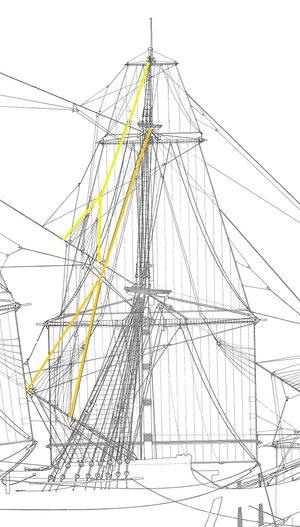
So, here's the controversy... Fred Hocker at the Vasamuseet doubts this rigging. Here is his personal communication to me:
Dear Paul,
We currently think that the fore and main topmasts had backstays, as did the mizzen, that led to the chainwales, but were probably set up on tackles rather than deadeyes. The angle of some of the chins, which can be measured accurately from the surviving chainwales and bolt holes, indicates that there was at least one backstay on each mast leading higher than the head of the lower mast, and the angle is good for the topmast head. The fore and mainmasts may have had two backstays each, the mizzen only one. As far as we can see, there is no evidence for topgallant backstays, although it is not impossible.
The backstays are not set up on the aftermost chain as in later ships. On the mizzen, the backstay looks to be between the third and fourth shrouds, while on the mainmast and foremast there appears t be a backstay between the last and next to last shroud, and possibly one farther forward.
Fred Hocker
Forskningsledare Vasamuseet, fil. dr / Director of Research, Vasa Museum, Ph.D.
He has said something similar on another forum (but, to be fair, others have read what he wrote on that other forum and arrived at a completely different conclusion than I have).
Anderson mentions running backstays on English ships for this period but doubts if there were standing backstays before 1640. He says Dutch ships may have had (single) backstays after about 1650.
So, what's the right way forward? I confess I like the look of the centerline backstays with their crowsfeet (though the main mast presents some difficulty because of the mizzen stay arrangement I showed you above). On top of that, some of the very best modelers have included centerline backstays (though not all of them). But who am I to question the conclusions of Mr. Hocker?
As I continue my research I'm going to run ratlines on the topmast shrouds and fix the lift blocks - and I would be pleased to hear your thoughts as well.
It has been quite a while since I have worked on my Vasa. Being on vacation didn't help - but I also feel like I lost my muse and wasn't really motivated once I returned from holiday. Well, today I tried to reboot my build with the challenging mizzen topmast stays. On the Vasa this has a somewhat unusual configuration in that the stay does not run to the main mast on the centerline. Instead, there are two stays with each running to the most aft shroud (port and starboard) of the main mast.
Here is the overall view:

Tensioning these lines was as tricky as you think it would have been. Here is a closer view from the other side of the ship:

My hero (PeterG) ran the tensioning line to a block/eyebolt on the deck and then to a cleat on the bulwark. I chose to forego the block and ran my line directly to a cleat...

And now I must drag you into an area of Vasa controversy: backstays. Some of my predecessors have included backstays at the centerline. I'll use the foremast as an example of how this is sometimes done by showing you the museum plans where I have marked in the backstays for the topgallant and topmast (I simply 'outlined' the crowsfoot arrangement terminating at the stays):

So, here's the controversy... Fred Hocker at the Vasamuseet doubts this rigging. Here is his personal communication to me:
Dear Paul,
We currently think that the fore and main topmasts had backstays, as did the mizzen, that led to the chainwales, but were probably set up on tackles rather than deadeyes. The angle of some of the chins, which can be measured accurately from the surviving chainwales and bolt holes, indicates that there was at least one backstay on each mast leading higher than the head of the lower mast, and the angle is good for the topmast head. The fore and mainmasts may have had two backstays each, the mizzen only one. As far as we can see, there is no evidence for topgallant backstays, although it is not impossible.
The backstays are not set up on the aftermost chain as in later ships. On the mizzen, the backstay looks to be between the third and fourth shrouds, while on the mainmast and foremast there appears t be a backstay between the last and next to last shroud, and possibly one farther forward.
Fred Hocker
Forskningsledare Vasamuseet, fil. dr / Director of Research, Vasa Museum, Ph.D.
He has said something similar on another forum (but, to be fair, others have read what he wrote on that other forum and arrived at a completely different conclusion than I have).
Anderson mentions running backstays on English ships for this period but doubts if there were standing backstays before 1640. He says Dutch ships may have had (single) backstays after about 1650.
So, what's the right way forward? I confess I like the look of the centerline backstays with their crowsfeet (though the main mast presents some difficulty because of the mizzen stay arrangement I showed you above). On top of that, some of the very best modelers have included centerline backstays (though not all of them). But who am I to question the conclusions of Mr. Hocker?
As I continue my research I'm going to run ratlines on the topmast shrouds and fix the lift blocks - and I would be pleased to hear your thoughts as well.
Last edited:
Hi Paul, I'm glad to see you back at your shipyard. The execution of your stays is a work of art, really fun to look at. I am still trying to sort out how I will proceed with the remainder of my stays and backstays. I actually like Billings interpretation of the single stay from the mizzen topsail forward to the mainmast top. There are going to be enough crow's feet to install on the running rigging as it is and for me the less I have to attach to the aft main shroud line the better. I think the remainder though will probably follow the museums PDF. Your work is just the best Paul!
- Joined
- Aug 8, 2019
- Messages
- 5,472
- Points
- 738

I found in my log better pictures and how Anderson explains. They where not always fit before 1650. After 1650 they where always mounted. So for the Vasa I would say mount them like Anderson discribes.
Here how the foremast is done
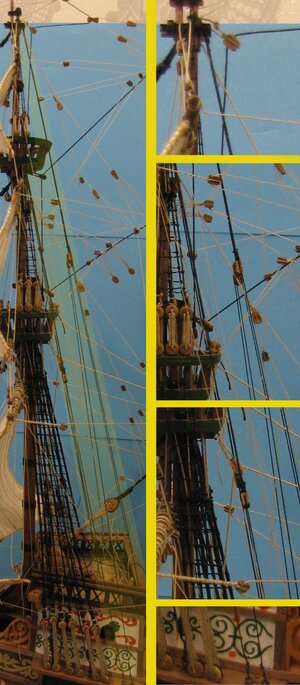
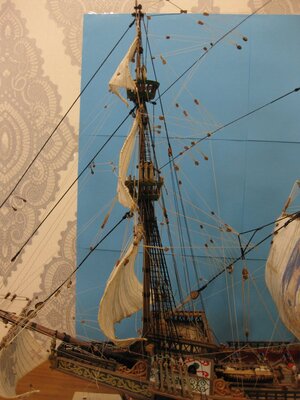
Discription in Anderson:
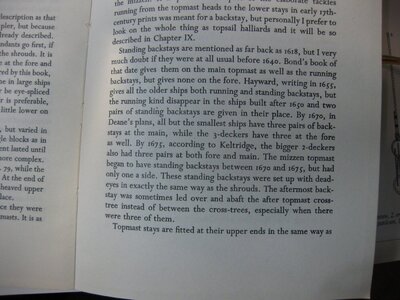
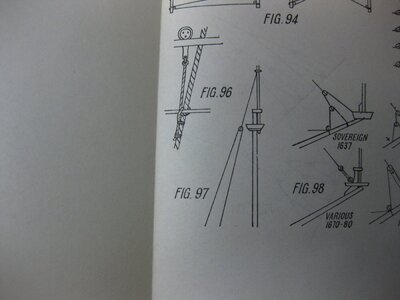

Peter Kirsch
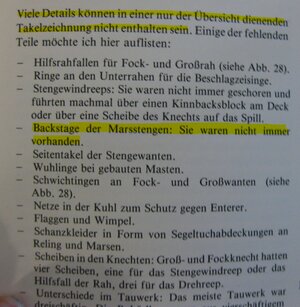
Translation: backsay of the topyard where not always attached
Full explanation Anderson:
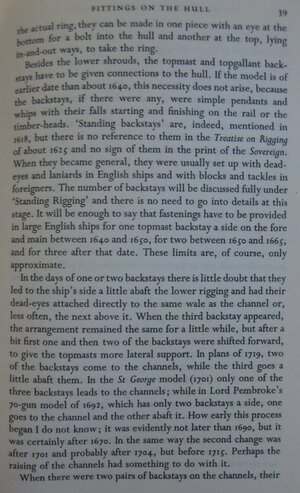
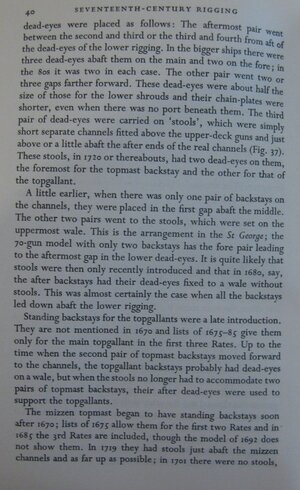

Hope this helps
Don"t look in Mondfeld, he tells they where mounted since 1550 (Dutch version) that must be wrong.
Here how the foremast is done


Discription in Anderson:



Peter Kirsch

Translation: backsay of the topyard where not always attached
Full explanation Anderson:



Hope this helps
Don"t look in Mondfeld, he tells they where mounted since 1550 (Dutch version) that must be wrong.
Hmmm. That might explain some of the conflicting reports I have read in various build logs. Getting this terminology right is going to be the death of me because there are so many errors immortalized in forum posts. I haven't done any reading on the running rigging thus far in Anderson so I better get to work!These are not the backstays, but the ties and halliards of the top- and toptalent yards.
The backstays I did this with a single tackle.
I hope that the pictures are clear. The Black rope are the backstays
View attachment 306901View attachment 306902View attachment 306903
- Joined
- Aug 8, 2019
- Messages
- 5,472
- Points
- 738

I made exact the same mistake confusing the ties and halliards with the backstays when I started reading the pictures and Anderson.Hmmm. That might explain some of the conflicting reports I have read in various build logs. Getting this terminology right is going to be the death of me because there are so many errors immortalized in forum posts. I haven't done any reading on the running rigging thus far in Anderson so I better get to work!
Yes, they are... top gallant back stays./ I used same arrangement, but limit them to top mast poz 3-1 on my drwng..These are not the backstays, but the ties and halliards of the top- and toptalent yards.
The backstays I did this with a single tackle.
I hope that the pictures are clear. The Black rope are the backstays
View attachment 306901View attachment 306902View attachment 306903
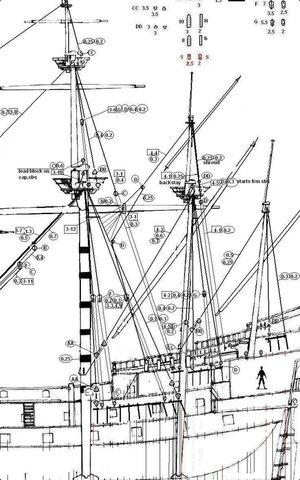 however F. HOKER told about a little bit different arrangements...phisicaly they should look like another mast tackles, well ... top mast tackles
however F. HOKER told about a little bit different arrangements...phisicaly they should look like another mast tackles, well ... top mast tackles Hi Paul,Hmmm. That might explain some of the conflicting reports I have read in various build logs. Getting this terminology right is going to be the death of me because there are so many errors immortalized in forum posts. I haven't done any reading on the running rigging thus far in Anderson so I better get to work!
Anderson wrote exactly same what were reproduced on the Vasa museum rigging plan / or wise wersa most probably
but I don't remember he wrote about backstays which could run and be secured to fhe main and top mast stays as you suggested...
backstays always settled in pair, to the port and starbord... this way they will work to keep mast steady with counter tension to the stays and wind load to the sails...
I could suggest to use Anderson as primary source of information but not any forums build logs, they are just secondary in importance and could make a big mess...and good only when doesn't contradict Anderson...
Or...could use them ,if You like some amateur version of rigging very much !!!
Last edited:
Hi Paul, If it were up to me, I'd run those backstays on each side down to the channels, the same as on La Couronne. Each running backstay would have a tackle allowing them to be adjusted from the deck if necessary. This appears to me to be the style for the continental shipbuilders in this early time period of the 1620's-30's. There seem to me that a lot of rigging changes occurred around 1650, and backstay changes were part of that. No one knows how long the transition to single, central backstays tied to forestays was, when that transition started, or who use the new backstay style before whom. In the face of such a lack of sample ships to compare, I would go with the older style which I stated previously over the new one, which also is the style that WasaMuseet stated. I think it's a safer bet. The location where the backstays would be attached to the channel would be inboard of the shroud deadeyes on each side, and at the fore-aft locations specified by WasaMuseet. We are guessing with minimal source knowledge here, and going on known historical trends.Hello Friends,
It has been quite a while since I have worked on my Vasa. Being on vacation didn't help - but I also feel like I lost my muse and wasn't really motivated once I returned from holiday. Well, today I tried to reboot my build with the challenging mizzen topmast stays. On the Vasa this has a somewhat unusual configuration in that the stay does not run to the main mast on the centerline. Instead, there are two stays with each running to the most aft shroud (port and starboard) of the main mast.
Here is the overall view:
View attachment 306893
Tensioning these lines was as tricky as you think is would have been. Here is a closer view from the other side of the ship:
View attachment 306894
My hero (PeterG) ran the tensioning line to a block/eyebolt on the deck and then to a cleat on the bulwark. I chose to forego the block and ran my line directly to a cleat...
View attachment 306895
And now I must drag you into an area of Vasa controversy: backstays. Most of my predecessors have included backstays at the centerline. I'll use the foremast as an example of how this is commonly done by showing you the museum plans where I have marked in the backstays for the topgallant and topmast (I simply 'outlined' the crowsfoot arrangement terminating at the stays):
View attachment 306900
So, here's the controversy... Fred Hocker at the Vasamuseet doubts this rigging. Here is his personal communication to me:
Dear Paul,
We currently think that the fore and main topmasts had backstays, as did the mizzen, that led to the chainwales, but were probably set up on tackles rather than deadeyes. The angle of some of the chins, which can be measured accurately from the surviving chainwales and bolt holes, indicates that there was at least one backstay on each mast leading higher than the head of the lower mast, and the angle is good for the topmast head. The fore and mainmasts may have had two backstays each, the mizzen only one. As far as we can see, there is no evidence for topgallant backstays, although it is not impossible.
The backstays are not set up on the aftermost chain as in later ships. On the mizzen, the backstay looks to be between the third and fourth shrouds, while on the mainmast and foremast there appears t be a backstay between the last and next to last shroud, and possibly one farther forward.
Fred Hocker
Forskningsledare Vasamuseet, fil. dr / Director of Research, Vasa Museum, Ph.D.
He has said something similar on another forum (but, to be fair, others have read what he wrote on that other forum and arrived at a completely different conclusion than I have).
Anderson mentions running backstays on English ships for this period but doubts if there were standing backstays before 1640. He says Dutch ships may have had (single) backstays after about 1650.
So, what's the right way forward? I confess I like the look of the centerline backstays with their crowsfeet (though the main mast presents some difficulty because of the mizzen stay arrangement I showed you above). On top of that, some of the very best modelers have included centerline backstays (though not all of them). But who am I to question the conclusions of Mr. Hocker?
As I continue my research I'm going to run ratlines on the topmast shrouds and fix the lift blocks - and I would be pleased to hear your thoughts as well.
Another reason why I think this, is because of the other features of Wasa which are older style as well. Bearing in mind that Wasa was a unique ship because it was lengthened halfway through building, and had MANY design changes added during the build process (which as combined spelt out the ships doom), the fast that there are no major changes in any features which are know to appear in later ships tells me that the Swedes were not going out on a limb and trying new style of ship features out. The only experimental changes that came about did so on the orders of the King, not part of the original design. There were some features of the Corel La Couronne model which were borrowed from later designs also, and were out of place for a 1630's man-o-war.
The Marine Engineer in me says that standing backstays attached to the forestays of the mast behind them is a bad idea from a support standpoint. Attaching the backstay to the channel offers far more support and is more rigid that attaching the backstay to the center of the run of the forestay. It makes the support of the topmast and topgallant totally dependent on the tension of the forestay. Should the forestay go slack, from a broken mizzen mast or severed forestay, the backstays for the main topmast would be lost. I think it better they were separate.
My $.02
Last edited:
That last post topic tired me out. ....think I'll take a nap.



